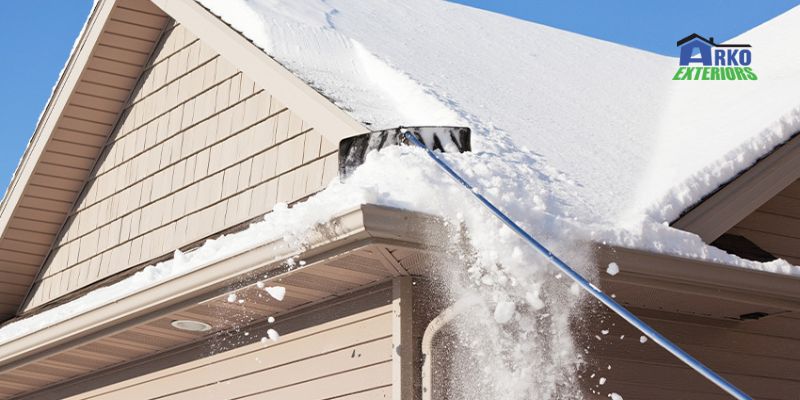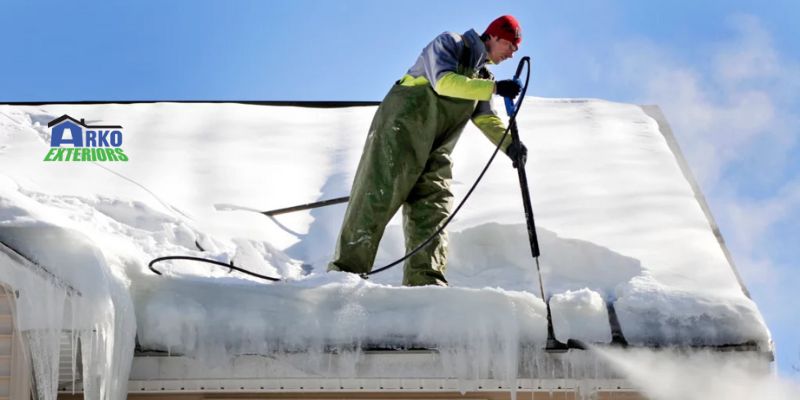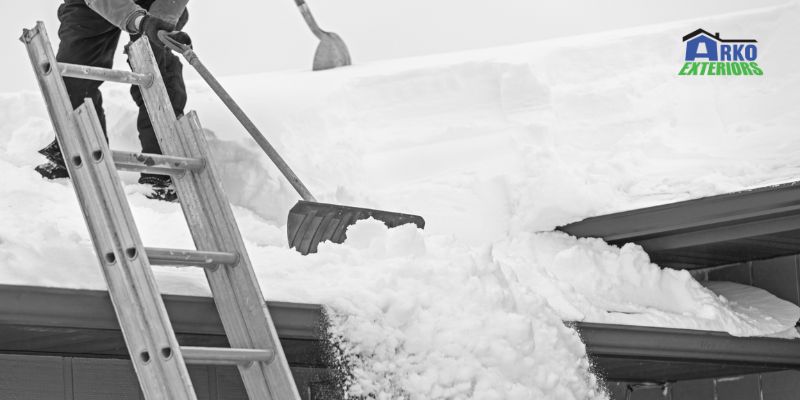There is lots of snow during winter. There is also an elevated risk of ice dams and leaks when snow builds up on your roof. Therefore, it is something you want to prevent as a homeowner. To ensure that your home’s safety is guaranteed, clean the excess snow off your roof.
How To Effectively Clear Your Roof of Snow This Winter
If you live in an area where it snows, you know that keeping your roof free of snow is just as important as clearing your driveway and sidewalks. While a few inches of snow is usually fine, if it starts to build up, the risk of ice dams increases.
Therefore, you must clear your roof of snow to prevent issues. Here are different ways to effectively do so:
1. Use a roof rake

During the winter months, when snow accumulates on your roof, you must take measures to prevent potential damage. One effective tool for removing excessive snow is a roof rake. Designed with a long handle, roof rakes allow you to safely reach the entire surface of your roof without the need to climb up.
By gently scraping the snow off your roof with the head of the rake, you can prevent snow buildup from becoming a hazard. As snow melts and temperatures drop, it can refreeze near your gutters, forming ice dams. By keeping the snow on your roof to a depth of one to two inches, you can minimize the risk of ice dams forming.
2. Steam snow removal

If you are dealing with a lot of snow and ice on your roof, a steam machine can be the right choice. Steam machines use hot water vapor to melt away snow and ice quickly and effectively. Roofing contractors often use them to remove ice dams, but you can also rent or buy one for smaller projects.
If you are not comfortable using a steam machine yourself, you can always hire a professional roofing contractor to do the job for you. You will have peace of mind knowing that your roof is in good hands.
3. Calcium chloride tablets
Calcium chloride is an effective deicing agent. It works by dissolving and breaking down ice and snow. It offers efficient snow and ice removal without requiring significant effort.
Unlike salt, calcium chloride does not harm or stain surfaces like roofs. However, if you have pets, it is advisable to use calcium chloride in areas they cannot reach, as certain brands may not be pet-safe.
4. Heating cables
While heating cables can effectively eliminate existing ice dams, their primary purpose is not to prevent them from forming in the first place. Instead, heating cables serve as a measure to address ice dams that have already developed.
If you notice ice dams beginning to accumulate on your roof, installing heating cables can be a good option. These cables are connected to an energy source and secured to the roof, generating heat that melts the surrounding ice and snow, creating channels for meltwater to drain effectively.
5. Do not use mallets or brooms
While it may be tempting to use everyday home items like mallets, brooms, or shovels to remove snow and ice from your roof, you should not. These tools can cause significant damage to your roof, leading to granule loss and cracked shingles. This, in turn, can make your roof more susceptible to leaks and other problems.
Rather than making use of these tools, it is recommended that you use a roof rake or a de-icing cable to remove snow and ice from your roof. Roof rakes have soft bristles that will not damage your shingles. De-icing cables are electric cables that are installed on your roof to melt snow and ice before they can build up.
Safety Tips to Follow When Clearing Your Roof of Snow in The Winter
Clearing snow off your roof can be a difficult task. For this reason, you should prioritize your safety. Here are tips that will ensure you are safe during the cleaning process:
- Seek help: Shoveling snow off your roof can be a dangerous task, so it is always a good idea to have a second person help you out. Having an extra set of hands can provide support and stability, and it can also help to ensure that you are following safe practices.
- Wear appropriate clothing: Effective roof snow removal demands appropriate attire and footwear to navigate the frigid conditions. Dress in warm, layered clothing to protect yourself from the cold. Also choose waterproof, insulated footwear to provide traction and keep your feet dry throughout the process.
- Observe the weather: It is important to be aware of the weather conditions when it is snowing. Winter weather can be unpredictable, and you need to be prepared for any changes in temperature, precipitation, or wind.
- Do not use harsh chemicals: Do not use rock salt or harsh chemicals to clear snow from your roof. These substances can promote the corrosion and decay of the roof structure and materials, leading to premature damage.
- Avoid using sharp tools: When removing snow from your roof, prioritize safety and avoid using sharp tools. Metal roofs are susceptible to damage from harsh tools or excessive force. Make use of gentle tools that will effectively remove snow without compromising the integrity of your roof.
Conclusion
A roof cleared of snow is essential for the integrity of your home. By following safe and effective snow removal methods, you can protect your roof from damage and ensure the safety of your home and family throughout the winter season. Remember to keep your roof clear of snow and ice to prevent damage to your property and to ensure your safety.

